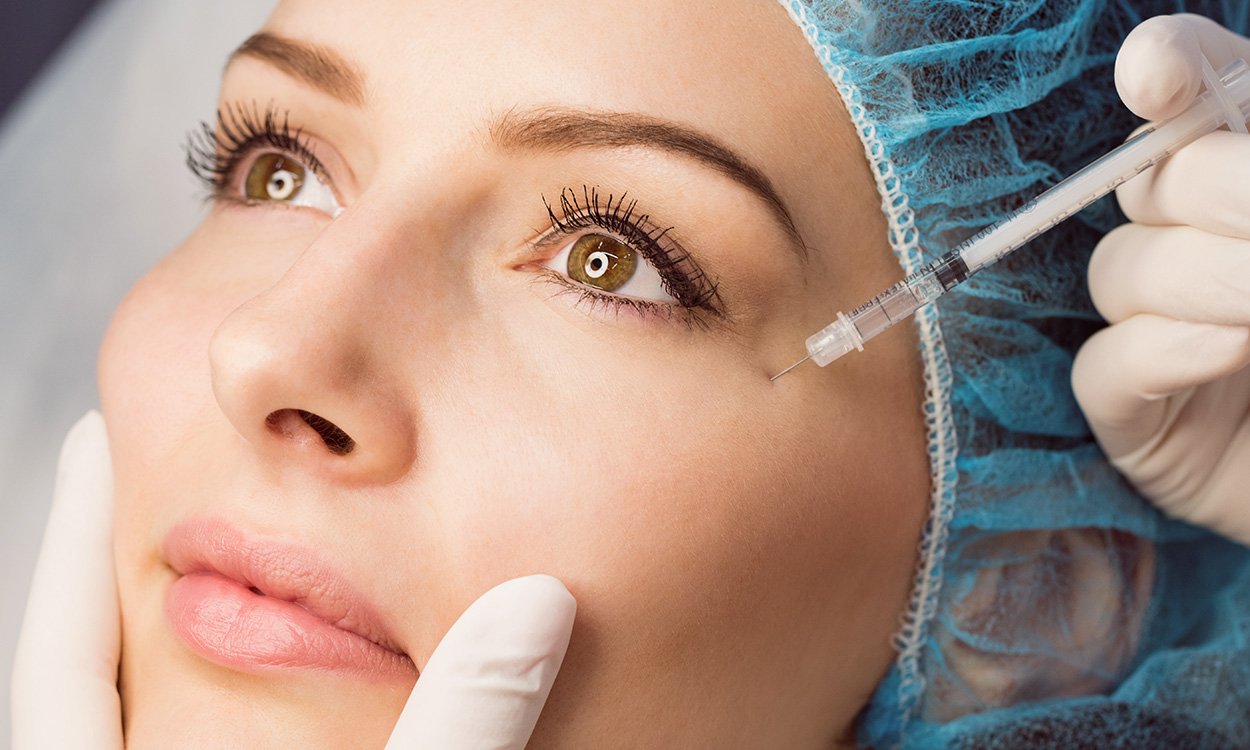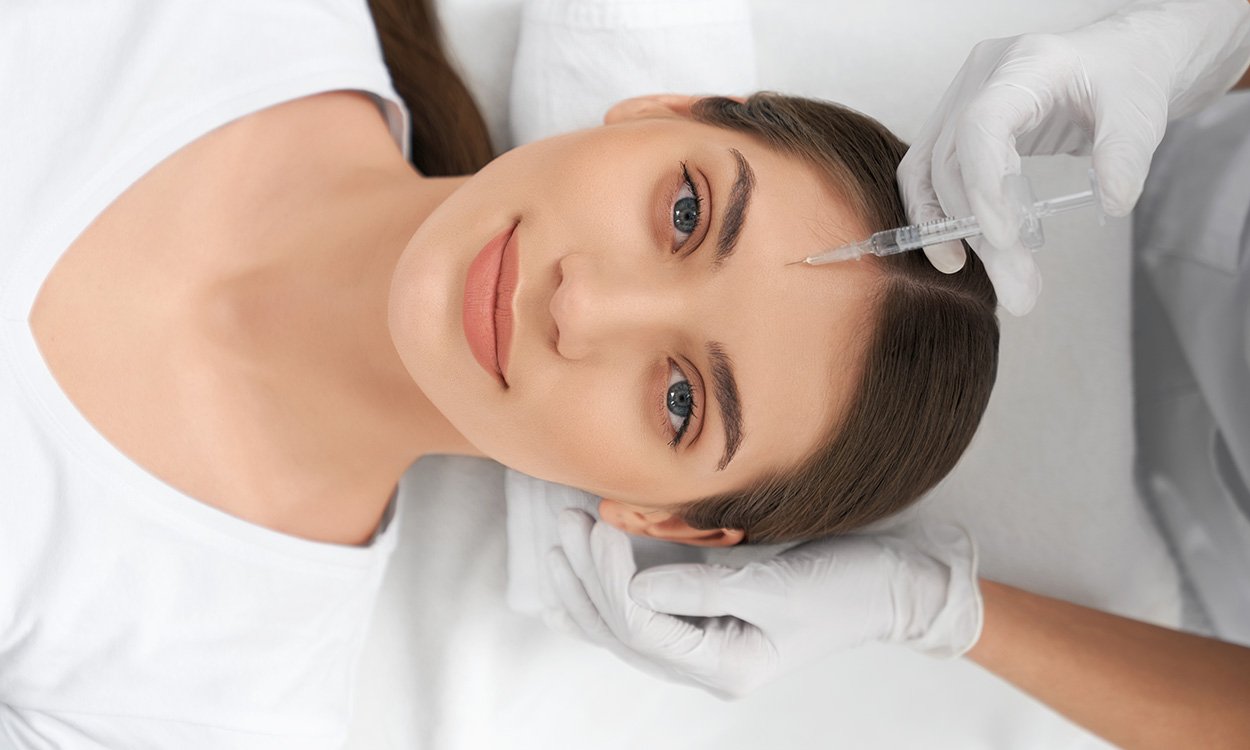The upper third of the face, including the forehead, eyebrows, upper and lower eyelids, and temples, is often the first area to show signs of aging. While the aging process is primarily determined by genetic factors, factors such as sun exposure, repetitive facial movements, and smoking are known to accelerate this process. During this process, hyaluronic acid, collagen, and elastin loss occurs, and the skin becomes loose. In the periorbital area, this leads to the formation and deepening of periocular, glabellar, and forehead lines, brow drooping, loss of temple fullness, fat loss in the upper and lower eyelids, eyelid drooping, deepening of the upper sulcus, photoaging, and hyperpigmentation. The primary goal of periorbital rejuvenation is to restore volume, soften and minimize wrinkles, and improve skin texture and color. (1)
Numerous topical treatments can be used alone or in combination to minimize periorbital aging. Sunscreens are vital for limiting aging caused by UV rays. When choosing sunscreens, products that provide broad-spectrum protection against both UVA and UVB rays should be preferred. (2) Niacinamide has been shown to improve skin texture and reduce hyperpigmentation and fine lines, while vitamins C and E have been shown to reduce the formation of epidermal keratinocytes due to UV damage. (3,4) Retinoids, which act similarly to vitamin A biologically, increase collagen synthesis, limit collagen breakdown, and improve skin smoothness. (5)
The history of injections into the skin for therapeutic purposes dates back to ancient Chinese and Indian medicine. In 1958, Michel Pistor used the term “mesotherapy” to describe the inoculation of drugs at the skin level. (6) The technique involves injecting drugs directly into the skin. These injections are based on the principle of delivering hormones, nutrients, drugs, and other substances into the subcutaneous layer. Initially developed to treat vascular and lymphatic disorders, mesotherapy has been used more frequently in the last decade for skin rejuvenation, lipolysis, and body contouring. How can I achieve a youthful and refreshed look around my eyes? The most common and simple formulation of mesotherapy for facial rejuvenation involves injecting a multivitamin solution into the dermis over multiple sessions. (7)
Periorbital hyperpigmentation (under-eye circles) is a poorly defined condition seen as bilateral, homogeneous brown-black pigmentation surrounding the eyelids and causes a tired appearance in the patient. (8) This condition can occur due to excessive pigmentation, thin and translucent lower eyelids, skin laxity, and shadowing caused by a deep tear trough. (9) Vitamin C injected with mesotherapy products inhibits the tyrosinase enzyme and has antioxidant effects, thus reducing periorbital hyperpigmentation and supporting collagen synthesis, which reduces dermal damage and leads to keratinocyte differentiation. (10)
Botulinum toxin was first used by ophthalmologist Dr. Alan B. Scott in the 1970s to treat strabismus (crossed eyes) by controlling eye muscles. (11) Its cosmetic use began in 1987 when another ophthalmologist, Dr. Jean Carruthers, discovered a reduction in wrinkles in patients while using Botox to treat eyelid muscles. What can I do to reduce periorbital wrinkles? Neurotoxins (Botulinum Toxin – Botox) are very common and versatile treatments for periorbital and forehead dynamic wrinkles as well as brow shaping. These naturally occurring toxins reduce muscle contraction by inhibiting the release of acetylcholine at the neuromuscular junction, leading to the softening of dynamic wrinkles. The effect usually lasts 3-6 months. (12) In periorbital rejuvenation, neuromodulation typically targets lateral canthal lines (crow’s feet), brow height and shape, and glabellar and forehead lines. (13,14)
Fillers are also used in periorbital rejuvenation, similar to Botox treatments. Volume loss is a natural part of the aging process, and fillers can be used to replace lost volume. In addition, fillers are an option for correcting static wrinkles and reshaping that cannot be treated with Botox. Hyaluronic acid fillers are most commonly used in periorbital rejuvenation. (15) Hyaluronic acid is a hydrophilic compound that attracts water, binds water as it is metabolized, and maintains its volume until it breaks down. (16) Interventions on the lower orbital rim and tear trough, resulting in a dark shadow/bruise on the lower eyelid, a sunken appearance of the eyeball, and under-eye circles, are common procedures in filler use.
1. Russel SM, Clark JM. Periorbital rejuvenation in the clinic: A state-of-the-art review. World J Otorhinolaryngol Head Neck Surg. 2023 Jul 28;9(3):242-248. doi: 10.1002/wjo2.124. PMID: 37780673;
2. Bucay VW, Day D. Adjunctive skin care of the brow and periorbital region. Clin Plast Surg. 2013;40:225‐236
3. Bissett DL, Oblong JE, Berge CA. Niacinamide: a B vitamin that improves aging facial skin appearance. Dermatol Surg. 2005;31:860‐866
4. Laethem AV, Claerhout S, Garmyn M, Agostinis P. The sunburn cell: regulation of death and survival of the keratinocyte. Int J Biochem Cell Biol. 2005;37:1547‐1553
5. Fisher GJ, Datta SC, Talwar HS, et al. Molecular basis of sun‐induced premature skin ageing and retinoid antagonism. Nature. 1996;379:335‐339.
6. Mammucari M, Maggiori E, Russo D, Giorgio C, Ronconi G, Ferrara PE, Canzona F, Antonaci L, Violo B, Vellucci R, Mediati DR, Migliore A, Massafra U, Bifarini B, Gori F, di Carlo M, Brauneis S, Paolucci T, Rocchi P, Cuguttu A, Di Marzo R, Bomprezzi A, Santini S, Giardini M, Catizzone AR, Troili F, Dorato D, Gallo A, Guglielmo C, Natoli S. Mesotherapy: From Historical Notes to Scientific Evidence and Future Prospects. ScientificWorldJournal. 2020 May 1;2020:3542848. doi: 10.1155/2020/3542848. PMID: 32577099; PMCID: PMC7305548.
7. AMIN, S. P., PHELPS, R. G., & GOLDBERG, D. J. (2006). Mesotherapy for Facial Skin Rejuvenation: A Clinical, Histologic, and Electron Microscopic Evaluation. Dermatologic Surgery, 32(12), 1467–1472. doi:10.1111/j.1524-4725.2006.32353.x
8. Sarkar R, Ranjan R, Garg S, Garg VK, Sonthalia S, Bansal S. Perior- bital hyperpigmentation: a comprehensive review. J Clin Aesthet Der- matol. 2016;9:49-55.
9. Sheth PB, Shah HA, Dave JN. Periorbital Hyperpigmentation: a Study of its prevalence, common causative factors and its association with personal habits and other disorders. Indian J Dermatol. 2014;59: 151-157.
10. Dayal S, Sahu P, Jain VK, Khetri S. Clinical efficacy and safety of 20% glycolic peel, 15% lactic peel, and topical 20% vitamin C in the constitutional type of periorbital melanosis: a comparative study. J Cosmet Dermatol. 2016;15:367-373.
11. Carruthers, A. (2002). Botulinum toxin type A: History and current cosmetic use in the upper face. Disease-a-Month, 48(5), 299–322.doi:10.1053
12. Erickson BP, Lee WW, Cohen J, Grunebaum LD. The role of neurotoxins in the periorbital and midfacial areas. Facial Plast Surg Clin North Am. 2015;23:243‐255.
13. Kane MAC. Nonsurgical periorbital and brow rejuvenation. Plast Reconstr Surg. 2015;135:63‐71.
14. Bertossi D, Nocini PF, Rahman E, Heydenrych I, Kapoor KM, Maio M. Non surgical facial reshaping using MD codes. J Cosmet Dermatol. 2020;19:2219‐2228.
15. Lee S, Yen MT. Injectable hyaluronic acid fillers for periorbital rejuvenation. Int Ophthalmol Clin 2013; 53(3):1–9.
16. Sharad J. Dermal fillers for the treatment of tear trough deformity: a review of anatomy, treatment techniques, and their outcomes. J Cutan Aesthet Surg 2012;5(4):229–38.




